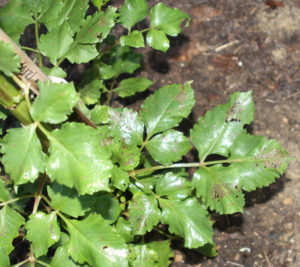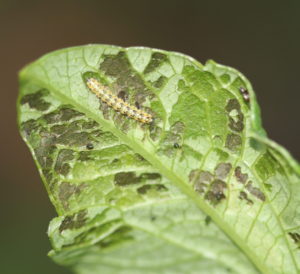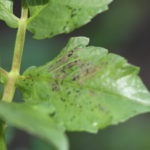Caterpillars can threaten your mid-summer flowers by directly feeding on blooms or defoliating your plant. Fortunately caterpillars take several weeks to grow into the large individuals capable of completely destroying your garden. If you learn how to identify the early warning signs, you could kill the caterpillars before they get big enough to cause significant damage. In addition, you can kill these young caterpillars without harming pollinators.
How to inspect your plants for early signs of caterpillars. Take some time every week, to inspect the leaves and petals of your flowers for chewed holes, or scraped leaf tissue. Young caterpillars are often too small to chew through leaves. Damaged leaves will appear to have darkened areas where caterpillars have scraped leaf undersides. Turn over the discolored leaves to confirm your diagnosis.
- Figure 1. Dahlia foliage scraped by young salt marsh caterpillars.
- Figure 2. Young salt marsh caterpillar scraping leaf tissue from the underside of a dahlia leaf.
Young caterpillars can chew through flower petals, because they are much thinner and more tender than leaves. Look for holes and on leaves and small caterpillars
It can take several days for a young caterpillar to remove enough plant or leaf tissue for you to notice that you have a potential problem. Look for small dark green pellets of caterpillar excrement that will accumulate on lower leaves.
How to control caterpillars. If plants are flowering, you can apply the pesticide directly to flowers and leaves if you use Bacillus thuringiensis (Kurstaki). This species of bacterium kills only caterpillars and not bees or fly pollinators. It works by tearing a hole in the insect gut. Professionals can use a product called chlorantranilprole (Acelepryn) that also kills caterpillars but not bees on leaves and flowers.
If plants are not flowering, or if you do not apply the product directly to blooms, you can use spinosad (Fertilome borer and bagworm killer, or Captain Jack’s Dead Bug). This product will kill caterpillars and bees but not the predators that keep spider mites from becoming a problem. Carbaryl (Sevin) and pyerthroids will kill caterpillars, bees and beneficial insects that keep mites from becoming a problem.



